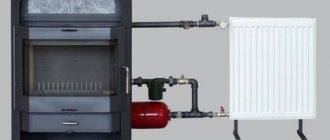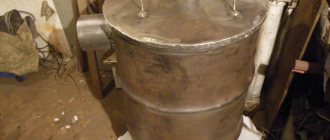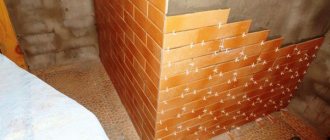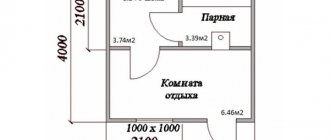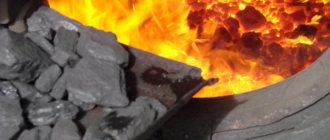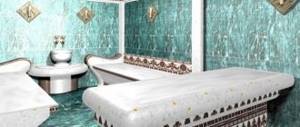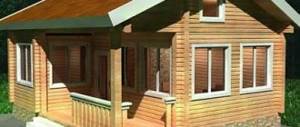Construction of a bathhouse is a rather expensive process. If you purchase all the equipment in a store, the steam room can cost a significant amount. Therefore, craftsmen and just people who want to see this structure on their plots strive to build a steam room with their own hands. Last but not least, this also applies to heating devices.
What is better: taking a ready-made cauldron to the bathhouse or making it yourself? To solve this dilemma, you need to consider all the pros and cons of making it yourself and identify possible difficulties that may arise during its production. It must be said right away that it is better not to try to make a gas boiler for a bath yourself.
Firstly, a self-made unit can fly into the air, taking the bathhouse with it.
Secondly, the operation of such equipment is strictly prohibited by safety regulations.
At the same time, you can make a boiler for a wood-fired sauna yourself if you have all the necessary equipment and your hands grow from the right place. Boilers for wood-burning saunas can be made from a metal barrel with thick walls, pipes or sheets of steel. There is no shortage of them in any subsidiary farm.
Main components of a sauna boiler
Any stove, including sauna boilers, consists of the following elements:
- A firebox in which the combustion process of wood, coal and other types of fuel occurs. It is made of thick metal. This is due to the fact that the firebox has the highest thermal load, metal of insufficient thickness will quickly burn out, and a homemade boiler for a bath will become unusable. A wood-burning boiler for a bath, namely a firebox, must be equipped with grates. Through them, ash from burnt fuel spills into the ash pan. The thickness of the metal from which they are made must be at least 0.5 centimeters.
- A chimney through which smoke is removed. When deciding how to make a boiler for baths, you need to thoroughly understand the principle of operation of the chimney system and carefully calculate its dimensions. The slightest mistake when installing a chimney can lead to insufficient efficiency of the stove (heat will go into the chimney) or an inability to cope with the removal of combustion products. The chimney must be equipped with a valve, with which the draft level is regulated. In winter, a tightly closed valve greatly contributes to the preservation of heat in the room. The chimney pipe may pass through the heater or be part of a heat exchange system.
- An ash pan designed to accumulate ash. This boiler element is located under the firebox. In addition to its main function, it is responsible for the supply of air, which is an integral component of the combustion process. When making a boiler for a bath with your own hands from pipes, you should carefully calculate the dimensions of the ash pan. It should be able to hold enough combustion products to be cleaned once a day.
- A heater that redistributes and removes thermal energy. It is a built-in or hanging container in which stones are placed. Its volume depends on the size of the boiler and steam room. A small heater will not be able to heat the room, and a large one will take too long to heat up. During this time, the water boilers have time to boil, which causes the room to fill with water vapor. At the same time, the steam room will become uncomfortable. The size of the heater and water tank should not be different. You can make a cauldron without a heater, but this is not entirely convenient. The room will be heated only from the walls of the boiler. In addition, it will not be possible to “give in to the park.”
- A water tank that is part of the heat exchange system. Cast iron sauna boilers with a water tank are the most common solution.
After the main components of the device that produces heat have been identified, we should move on to the main question: how to make boilers for a bath from scrap materials?
Installation recommendations
Long before making a boiler for a bath, you need to decide on the location and diameter of the chimney pipe. The design of a homemade stove should take these points into account, so that later you don’t have to make several turns of the chimney, which will affect its service life. If you decide to place a tank for heating water on a pipe, then it should rise straight up and go through the roof. Starting from the ceiling lining and until the very end, it is recommended to use two-layer sandwich pipes for the chimney. The temperature of the flue gases in it is quite high, so the pipe should not be in direct contact with the elements of the ceiling and roof. A detailed diagram of how to install a boiler in a bathhouse is shown in the figure.
Boiler installation
The unit cannot be placed on floors; it requires a foundation in the form of a slab of concrete or brick. Wall surfaces lined with wood that are nearby must be protected from heat flow using screens made of basalt materials. Some homeowners are thinking about how to paint the boiler in the bathhouse in order to improve the interior. There are special industrial high-temperature paints, but their use is impractical. The burning temperature of wood is 600 ºС, any paint will have to be renewed frequently, and its cost is very high. It is better to install a heater on the entire body, as described above, or line the boiler with ceramic bricks.
Article on the topic: How to weld a sauna stove from a pipe
What materials and tools are needed to make a boiler?
Boilers for steam rooms in Russian baths are made using the following tools:
- welding machine;
- grinders, with a cutting wheel designed for working with metal.
We’ll talk a little later about how homemade sauna boilers are made from a pipe or barrel. First, we should talk about the most common sheet metal option. In addition to this you will need:
- small pieces of reinforcement and channels - they are needed for the manufacture of internal partitions;
- a thick sheet of metal (minimum 0.5 centimeters) - it is necessary for the production of grate bars;
- pipe with a diameter of at least 10 centimeters;
- awnings for firebox and vent doors;
- faucet for tank.
When talking about how to weld boilers for a bath, we should mention the manufacture of a heat-distributing screen. It is best made from brick. All you need to do is to tightly surround the boiler with it.
Manufacturing options
There are several basic options for making sauna boilers with your own hands. Drawings of the device must be made as accurate as possible to avoid various errors during assembly.
From a metal pipe
This method of creating a boiler is considered the most popular and most used. Most often, thick-walled metal pipes are used as the main material. It is best to use blanks with a diameter of at least 50 cm and a length of approximately 1 m. With their help, you will get a device capable of heating a steam room with an area of 9 square meters.
The boiler manufacturing process is simple and consists of the following steps:
- Three identical pieces with a diameter of 1.4 cm and a length of 30 mm are cut from the reinforcement. These parts will be used as supports for the body of the product.
- A circle (the bottom of the future device) of the same diameter as the pipe is cut out of a sheet of steel.
- A metal lid for the stove is cut from a piece of material.
- A hole is made in the middle. Its size must exactly match the diameter of the chimney.
- A hole is formed at the bottom of the pipe.
- Then the box is made. A separating part should be provided inside it, which will form two chambers: for the firebox and for the ash.
- At the next stage of work, the assembly of the structure begins. First of all, the manufactured box is welded, which should go outside or into the combustion chamber.
- The chimney pipe is inserted into the pre-made hole.
- Then the foundation for the furnace is equipped. It can be a concrete screed or a reinforced concrete slab.
- The device is installed on it, and heavy stones are placed on top of the lid.
- At the very end, a brick heat shield is built. You can make it in the form of a small wall or cover the entire boiler.
From sheets of metal
This manufacturing option is distinguished by its simplicity and accessibility. The work uses inexpensive sheet steel with a diameter of 5 and 10 mm, as well as some materials that can be bought at any hardware store in the city.
To independently weld a sauna boiler from metal sheets, you need to perform several simple operations.
Procedure:
- A drawing of the future product is drawn with a detailed representation of the most important components.
- Separate blanks of the required size are cut from purchased sheets of metal. Moreover, they must exactly correspond to the manufactured diagram of the sauna boiler.
- A piece of thick-walled material is folded over and forms the body of the device.
- Then the edges are welded to each other. It is important to make the seam as smooth and high quality as possible. If there are no opportunities or skills to carry out such work, then it is best to hire a qualified specialist.
- A piece of pipe is welded into the inside of the manufactured body.
- Then a water tank is formed.
- A wide hole is made in the combustion chamber and a chimney pipe is installed into it.
- A special valve is attached to it, which will control the traction force.
- A combustion door is attached to the structure.
- A small tube for connecting a tap is attached to the back of the boiler.
- A protective brick screen is built around the device. Thanks to it, the negative impact of high temperatures on people will be reduced. In addition, it will protect against accidental touch and severe burns.
Making a boiler for a sauna with your own hands is a rather difficult undertaking that requires a significant investment of time and money. With the right approach to business and following all recommendations, you can make high-quality equipment that will work correctly for many years and bring pleasure to people.
Barrel stove
How to choose boilers for baths? What material should be used for their production?
Such decisions should be made independently, taking into account the availability of components. Some people find it more convenient to use sheet iron, while others think that it is better to make boilers for a bathhouse with your own hands from a barrel or pipe. They are no different and boast the same heating of water in containers and the room as a whole. The difference lies in the method of production.
To be fair, it must be said that it is much easier to make a boiler for a bathhouse with your own hands from a barrel. This is the simplest design. All you need is to find a metal container with a wall thickness of at least 0.3 centimeters. Thinner metal will burn quickly.
You need to make a boiler for a wood-burning sauna from a barrel in the following order:
- The bottom of the container is completely cut out. Instead, a sheet of iron with a thickness of at least 0.5 centimeters is installed. It is necessary to weld the legs to it in advance, which can be made from scraps of a T-beam.
- At a height of 5–7 centimeters from the bottom, you need to cut out a small window (approximately 20x15 cm). The blower door will be installed at this location. It is made from a sawn piece. You need to weld the hinges and handle to it, and then install it in its rightful place.
- The second door of the future boiler for a wood-burning sauna is installed 20 centimeters above the vent. It should be significantly larger than the first one (approximately 25x45 cm). Otherwise, the logs will not fit into it.
- A boiler for a wood-fired sauna contains grates in its design. They need to be placed 5–7 centimeters below the firebox door.
- A heater must be placed above the firebox. The most convenient place for its location is the second third of the barrel. The partition between these sections of the boiler should not be continuous. It is made from channels. The size of the heater is equal to the second third of the barrel. A door is needed in the middle of the heater. Stones are laid through it and water is poured in, if desired, to “give it to the park.”
- From a barrel you can make a boiler for a sauna with a tank. To do this, use the remaining third of the barrel. The heater and tank are separated by a solid partition, the seams are thoroughly boiled. A chimney pipe must be installed in the center of the tank.
Having studied the drawings of such structures, you can easily build a stove. There's nothing complicated about it. All you need to make a sauna cauldron with your own hands is to strictly follow the existing instructions. Before operation, the manufactured sauna boiler must be cleaned of scale and rust.
If desired, it can be painted with heat-resistant paints and varnishes. That's all. A DIY cauldron made from a barrel is ready. It can be installed in a bathhouse.
Heating into a bathhouse from a pipe is done in the same way. The only exception is the initial stage. You will not have to cut out the bottom of the barrel, but you will need to maintain the dimensions by cutting a pipe 1.2–1.4 meters long.
Pros and cons of electric sauna boilers
Advantages of electric boilers in comparison with other devices:
- environmental cleanliness. There are no combustion products that are emitted by all other boilers (solid and liquid fuel, gas). This is an important advantage, because a bathhouse is not so much a hygienic as a health-improving facility;
- the boiler does not dry the air, unlike other electrical appliances - oil radiators, convectors;
- ease of installation - no chimney, additional hood, connection to the gas main, etc. are required;
- compactness. For a wall-mounted model (it is more than enough for a bathhouse) you do not need a separate room (what is a wall-mounted electric boiler);
- control and maintenance are fully automated - no need to add firewood or regularly look at the thermometer;
- independence from fuel. Unlike the centralized gas supply, electricity is available in any locality. No need to bring firewood, gas cylinders, etc.;
- saving time. Many models have a remote control option. This means that by the time you arrive at the dacha (returning from fishing, skiing), the bathhouse will already be heated;
- Fire safety. Electric is the only boiler that does not use an open flame to heat the coolant;
- affordable price.
A combination boiler (electricity plus one or two furnaces for wood, gas, etc.) will be expensive, but there is no point in purchasing it for a bathhouse that is used from time to time.
In case of a power outage, the household must have a generator regardless of the heating system, because... In the countryside, power outages occur much more often than in the city (diesel generators for power supply to private homes and cottages).
And for lovers of classic bath procedures, you can put a regular heater in the bathhouse.
The downside of an electric boiler (apart from expensive energy) is its vulnerability to network power surges. If the model does not have a built-in filter, you will have to purchase a stabilizer. The peculiarity of the bath is high humidity.
Sheet iron heating device
A similar stove with a metal boiler for a bathhouse is the most difficult to produce. This is due to the fact that there will be no prepared workpiece. Fundamentally, such a device is no different from the one described above. It also contains 4 compartments: an ash pan, a firebox, a heater and a tank.
The production of such a furnace will take longer. You will especially have to tinker with the water tank, which should be practically sealed. But the result will be a product no different from what was produced at the factory.
Horizontal boiler for a bath
Along with vertical heating devices, homemade stoves made from pipes and barrels with a horizontal design are no less popular. These products are easy to make:
- You need to take a two-hundred-liter barrel and cut several holes in it. Two of them are intended for installing a heat exchange pipe. It should pass right through the barrel. Two more will serve as a blower and firebox door. The last hole is necessary for installing the chimney.
- You can make a heater in the upper part of the future stove. Part of the barrel is cut off, and reinforcement bars in the form of a lattice are welded in this place. Next, you need to weld a structure from sheets of iron in the shape of an unfinished inverted pyramid.
- The stove blank is equipped with legs, after which it must be connected to the chimney and heat exchange system.
Making such a structure is no more difficult than a boiler made from a barrel installed vertically. The disadvantage of this product is that it takes up a lot of space.
Electric heating in the bathhouse
If there is a need to heat only the steam room, then the ideal solution is a solid fuel stove. Otherwise, when you need to heat the dressing room, shower room and other rooms in the bathhouse building, this option can be safely discarded.
To heat a large area, it is better to use an electric boiler. Its production and installation do not have any technical difficulties. All that is needed is to weld the water heating elements into a container of water and properly arrange the heat exchange system.
The advantages of sauna boilers running on electricity are obvious:
- there is no need to equip a chimney system;
- ease of installation, operation and maintenance;
- high efficiency.
Along with the advantages, there is a significant drawback: significant energy consumption.
Functionality of an electric boiler for a bath
When choosing an electric heating boiler for a bath or sauna, experts recommend giving preference to models with maximum functionality.
In this case, installing the unit will not require additional costs for you to complete the installation with separate units, unlike cheaper, but not fully equipped boilers. Please note the presence of the following elements: expansion tank, circulation pump, safety valve and fine coolant filter. There is no point in skimping on functionality - it is better to give preference to a less modern design and not overpay for unnecessary options.
An equally important selection criterion for electric boilers for a bath or sauna is the organization of safe operation of the unit. It is advisable that the model you choose be equipped with an automatic shutdown system in case of unfavorable operating conditions, for example, when the coolant pressure drops (very low or very high pressure levels), overheating of the heating block or freezing of water.
Separate boiler operating modes (winter/summer) can be very useful. They will help make the operation of the device more economical. For the same purpose, we recommend taking a close look at models with a chronothermostat.
